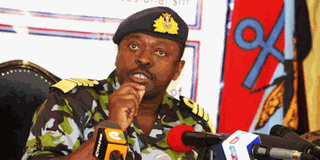General Mwathethe says East Africa armies set for joint military exercises

Chief of General Staff Samson Mwathethe addresses a press conference at Department of Defence (DOD) in Nairobi on January 21, 2016. PHOTO | ROBERT NGUGI | NATION MEDIA GROUP
What you need to know:
Chief of Defence Forces Samson Mwathethe said a unified force would help to defeat terrorism and protect economic interests of member countries.
- More than 250 officers and servicemen and women from the five East African member states took part in the initial command training that ended Wednesday.
The training took place at the Humanitarian Peace Support School, Embakasi Garrison, Nairobi.
Militaries in East Africa are set to begin joint field exercises as part of an ambitious plan to build a coalition force in the region.
Chief of Defence Forces Samson Mwathethe said a unified force would help to defeat terrorism and protect economic interests of member countries.
In a speech read by vice-CDF Joseph Kasaon, General Mwathethe revealed that the field exercises would take place in Kenya this year.
“Exercises are meant to prepare forces on how they will conduct operations when the need arises,” said Gen Mwathethe. “Countries have different doctrinal of conducting operations; combined joint exercises are meant to enhance interoperability.”
More than 250 officers and servicemen and women from the five East African member states of Kenya, Uganda, Tanzania, Burundi and Rwanda took part in the initial command training that ended Wednesday. They were expected to train their colleagues.
The training took place at the Humanitarian Peace Support School, Embakasi Garrison, Nairobi.
“Peaceful coexistence is no longer confined within our borders,” the general noted. “The modern-day soldier is confronted by a faceless and borderless enemy.
“We are fighting ideologies that transcend borders. I am confident cooperation in defence will overcome these challenges.”
The Kenyan military chief cited the threat posed by Somalia-based terrorist group Al-Shabaab.
The force is also necessary because of the anticipated economic boom in Uganda and Kenya with oil production, as well as natural gas in Tanzania.
The region, including South Sudan, covers 2.4 million square kilometres and has a population of 170 million.
Police and civilian experts have been included in the joint exercises, which are in line with the EAC Protocol on Defence Cooperation.
There also exists an East African Standby Force comprising eight additional countries that is mandated to send troops to war-torn nations in the region. Article 4(h) of the AU Constitutive Act provides for deploying troops to a member state under circumstances of war crimes, genocide or crimes against humanity without that country’s permission.




